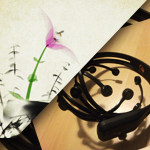
Cerebral Interaction and Painting
The research focuses on combination of novel technology and traditional art. In this paper, a novel interactive art installation (IAI) using user’s thought to interact with a digital Chinese ink painting is introduced. Meanwhile, the final purpose of this research is to establish a link between novel technology and traditional arts and further to bring out traditional art philosophy by taking the advantages of novel technology. Finally, this research aims to help people understand not only the visual expression of an art, but also its philosophy and spirit through different kinds of interaction. Based on this, the theory research focuses on four parts: traditional art philosophy, artistic and cognitive psychology, traditional art, novel technology. Meanwhile, for practice, a Chinese style IAI experiment including brain waves control technology is introduced to help people better understand the purpose of this research.
Yiyuan Huang
University Paris 8

Topics on Bible Visualization: Content, Structure, Citation
Text visualization starts with understanding of the text itself. To understand any text, understanding the text itself and its traits should be preceded before visualization process starts. Only after text traits were deduced from the full understanding of the text, the goal and expression methods should be decided. This study reviews various Bible visualization cases. Without deep understanding of the text itself and its unique traits, the design and interpretation of visualization clearly have limits. Different visualization approaches can be conducted depending on the unique traits of the text. In this sense, it is important to set a goal for visualization and find the right approaches for that goal based on the systematic analysis and examination. This study aims to build theoretical foundation which helps choose the right materials and approaches for visualization by analyzing more diverse examples from various point of views.
Hyoyoung Kim
Chung-Ang University

SwarmVision
Initiated by research in autonomous swarm robotic behavior and computational driven machine vision, SwarmVision is an installation consisting of multiple Pan-Tilt-Zoom cameras on rails that behave autonomously based on programmed rules of computer vision. Each of the cameras are programmed to detect visual information of interest based on separate algorithms, and each negotiates with the other two, influencing what subject matter to study in a collective way.
George Legrady
University of California, Santa Barbara






